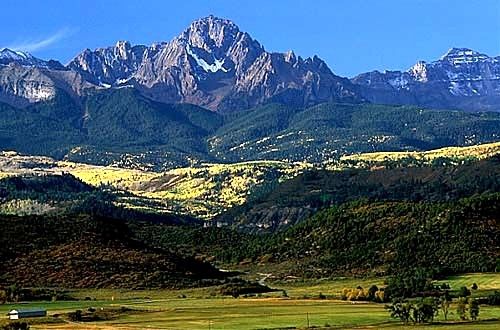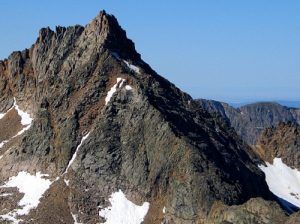By Diane Winger

Mt. Sneffels tops out at 14,150 feet. Photo courtesy My Colorado
Have you caught the bug yet? The desire to climb a mountain with a summit rising at least 14,000 feet above sea level has reached near-epidemic proportions in Colorado, with estimates of roughly 500,000 hikers and climbers making their way up a Fourteener each year.
The good news is that a number of Colorado’s 54 Fourteeners can be climbed by anyone with good stamina and overall fitness. That’s also the bad news. People who know little about the special risks of hiking in the mountains often set out along a well-marked and well-traveled trail up a Fourteener ill-equipped for the venture. Hypothermia and dehydration are two of the dangerous and all-too-common problems that might await hikers who aren’t prepared.
It was the Fourth of July weekend, and we headed to the mountains, escaping Denver’s 95-degree heat. As we approached the summit above tree-line (trees can’t grow above a certain elevation; in Colorado, that elevation is around 11,000 to 12,000 feet), it began to snow. Hard. And blow. Harder. We donned our wind pants and warm coats, hats, and gloves, and continued to the top.
There we found a hiker who had passed us on the trail earlier in the day. He was dressed in running shorts and a light shirt, wearing tennis shoes (which were quite wet by now), and carrying a small, empty water bottle. He was shivering violently. People began bundling him up in their extra warm clothing, giving him food and water, and then helped him back down the trail.
Here are a few basic “rules” to remember before heading up that mountain trail (even when hiking up peaks lower than 14,000 feet):
- Bring along extra layers of clothing. No matter how beautiful and warm the weather is when you start out, temperatures can plummet and you can get soaked if a thunderstorm moves in.
- Thunderstorms are extremely common in Colorado’s mountains during summer afternoons. Plan your day so you can be leaving the summit and heading back down the trail no later than noon. Watch the sky for cloud build-up, and turn around earlier if a storm seems to be forming early.
- Carry plenty of water, and drink frequently. Even in cool weather, you’ll probably need to drink a minimum of 2 quarts of water during your hike to and from the summit of one of the “easier” Fourteeners. That amount of water is on the low side for many people.
- Some of the other “essentials” to bring along: food (snack frequently – don’t let yourself run out of “fuel”), map & compass (and know how to use them), fire starter, flashlight or headlamp, 1st Aid kit, sunglasses, and sunscreen.
- Hike with a buddy. That cold, wet guy was lucky that other people came along to help him. Imagine what would have happened if he had been alone for another 30 minutes!
These tips are just a start to help you hike more safely in the mountains. Consider joining a hiking club before tackling higher peaks in Colorado. You’ll find some new hiking partners, learn more outdoor skills, and probably have a great time to boot.
Let’s head for the hills!
****

Sunlight Peak from Jagged Mountain, photograph by Steve Hoffmeyer, courtesy Fourteener World.
Several of the “easier” Colorado Fourteeners are:
Mount Sherman
Quandary Peak
Mount Elbert
Mount Evans
Mount Belford
Diane Winger ©2004 All Rights Reserved
About The Author: Diane Winger is co-author of “Highpoint Adventures – The Complete Guide to the 50 State Highpoints”, and other guidebooks. Article source: Article City
Also See:
